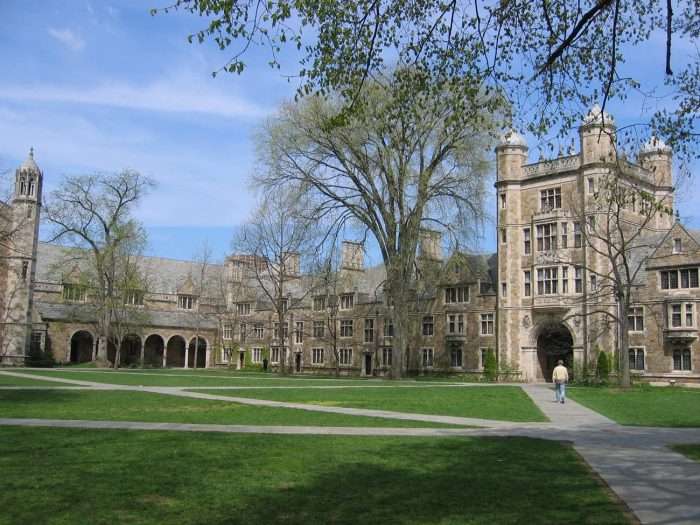The Ivy Coach Daily
What Is a Good GPA?

What exactly marks a good grade point average, or GPA as it’s often called? What kind of GPA will impress admissions officers at America’s elite universities? The short answer is that it depends on several factors. So let’s dive in and learn all about the grade point average, its history, and its use in the modern admissions system.
History of the Grade Point Average
The modern grade point average, or GPA, as we know it today, traces back to the Ivy League. Back in 1785, at Yale University, its president, Ezra Stiles, created a four-point grading scale to distinguish its top-performing students. The four-point scale, however, was not numerical. Instead, the scale consisted of four categories: Optimi, second Optimi, Inferiores, and Perjores.
Fast forward to 1832, when Yale rejiggered the four-point scale to be numerical, and the modern grade point average used by high schools and universities around the world was born.
How to Calculate a GPA
Every high school and every university calculates a GPA differently. Some high schools, for example, weight GPAs, meaning they numerically assign gravitas to grades stemming from more rigorous coursework. It’s common, therefore, that students have a 4.3 or 4.4 GPA on a 4.0 scale. It’s why comparing a GPA for a student from one high school to a student from another can be like comparing apples and oranges.
At Ivy Coach, it never ceases to amaze us how many parents of prospective clients blurt out their child’s GPA before we even say hello — as though the GPA means anything at all without the context of their high school, the rigor of their courses, their grades, and more.
Weighted vs. Unweighted GPA, Calculated vs. Not Calculated GPA
No general rule of thumb exists for how various high schools and universities scale their GPA calculations. One school might use a 4.0 scale, another a 5.0 scale. One school might weight grades, and another might not. One school might not allow students to enter a GPA on their Common Application, while another might include it on students’ transcripts. It’s the Wild West out there! It’s why every high school transcript is accompanied by a school profile that typically outlines the GPA scale, available courses at the school, weighting, and more.
Below are examples of how two schools might calculate GPAs differently:
Letter Grade | Numerical Grade Range | GPA |
| A | 95-100 | 4.0 |
| A- | 90-94 | 3.7 |
| B+ | 86-89 | 3.4 |
| B | 83-85 | 3.0 |
| B- | 80-82 | 2.7 |
| B- | 80-82 | 2.7 |
| C+ | 77-79 | 2.3 |
| C | 73-76 | 2.0 |
| C- | 70-72 | 1.7 |
| D | 65-69 | 1.0 |
| F | Below 65 | 0 |
School #2
| Letter Grade | Numerical Grade Range | GPA |
| A+ | 97-100 | 4.0 |
| A | 93-96 | 4.0 |
| A- | 90-92 | 3.7 |
| B+ | 87-89 | 3.5 |
| B | 83-86 | 3.0 |
| B- | 80-82 | 2.7 |
| C+ | 77-79 | 2.3 |
| C | 73-76 | 2.0 |
| C- | 70-72 | 1.7 |
| D | 65-69 | 1.0 |
| F | Below 65 | 0 |
You’ll note that the variations on these two scales are slight, yet they can make all the difference. At School #1, a student with an 86 average has a 3.4 GPA, whereas a student with an 86 at School #2 has a 3.0 GPA. It’s why GPAs must always be evaluated in context.
How the University of Michigan Calculates GPA in College Admissions
And it’s not just high schools that calculate GPAs differently. Many colleges don’t rely on high schools to calculate GPAs. Instead, these colleges recalculate GPAs based on their systems.
The University of Michigan is a well-known example of a school that has its unique way of calculating an applicant’s GPA. Michigan has historically recalculated an applicant’s GPA rather than relying on the high school’s calculation. Until 2009, Michigan used only the five core subjects from tenth and eleventh grades — English, history, math, science, and foreign language — to tabulate a student’s GPA. Ninth-grade marks, at the time, were not considered in this calculation, nor were marks in subjects outside of the core five disciplines.
But, nowadays, Michigan includes ninth-grade marks in its calculation of GPA. And while the university does not give added weight to honors or Advanced Placement courses, the elite public institution expects to see students taking these courses. For students who record an A+, A, or A-, the admissions committee tabulates it as an A of 4.0. Likewise, a B+, B, or B- is tabulated as a B or 3.0, and so on.
Under Michigan’s current scale, we have never seen a student earn admission with below a 3.7 GPA. However, if the next Tom Brady or Chris Webber came around, we imagine the public institution would lower its standards on a case-by-case basis.
| Grade | Assigned GPA by Michigan in College Admissions |
| A+ | 4.0 |
| A | 4.0 |
| A- | 4.0 |
| B+ | 3.0 |
| B | 3.0 |
| B- | 3.0 |
| C+ | 2.0 |
| C | 2.0 |
| C- | 2.0 |
| D | 1.0 |
| F | 0.0 |
Not All GPAs Are Created Equal in College Admissions
But while the GPA scale may be fairly standardized at high schools and universities worldwide, all GPAs are not created equal. After all, a student at a competitive high school like the Thomas Jefferson High School for Science and Technology in Alexandria, Virginia, might have a comparatively low GPA compared to a student from, say, North Polk High School in Alleman, Iowa. Does that mean the North Polk High School student enjoys an advantage?
No, because admissions officers don’t merely plug in some numbers on a calculator and determine who gets accepted and denied. GPAs are not analyzed in a vacuum. Instead, GPAs are examined in context, including the competitiveness of the high school the student attends and the rigor of their coursework.
A student with perfect grades in regular courses does not have a leg up in admissions over a student with nearly perfect grades in all Advanced Placement courses. And a student with perfect grades at a less competitive high school does not have a leg up over a student with near-perfect grades at a competitive high school that admissions officers respect.
Not All GPAs are Created Equal in Graduate School Admissions Either
And, by the way, the same is true in graduate school admissions. A student with a perfect GPA from Susquehanna University does not have a leg up in medical school, MBA, law school, or other master’s or Ph.D. program admissions over a student with a near-perfect GPA from Princeton University — irrespective of what Malcolm Gladwell may have people believe to the contrary.
But GPAs Can Still Be Used Somewhat As a Measuring Stick
All caveats aside, a student with a 2.0 GPA in rigorous coursework from a top high school like Phillips Exeter Academy is unlikely to earn admission to elite universities. GPA still does matter — just not as much as so many parents and students often think.
The GPA Data for College Admission at America’s Top National Universities
Below you will find an in-depth exploration of the GPA data available at each of the top 25 national universities in the 2024 US News & World Report college ranking.
| College/University | 2024 US News Rank (“Best National Universities”) | GPA Information |
| Princeton University | #1 | Percent who had GPA of 4.0 – 68.41%; Percent who had GPA between 3.75 and 3.99 – 25.4%; Percent who had GPA between 3.50 and 3.74 – 3.7%; Percent who had GPA between 3.25 and 3.49 – 1.75%; Percent who had GPA between 3.0 and 3.24 – 0.67% |
| Massachusetts Institute of Technology | #2 | Percent in top tenth of high school graduating class – 97%; Percent in top quarter of high school graduating class – 100% |
| Harvard University | #3 | Percent who had GPA of 4.0- 74.3%; Percent who had GPA between 3.75 and 3.99 – 20.47%; Percent who had GPA between 3.50 and 3.74 – 4.04%; Percent who had GPA between 3.25 and 3.49 – 0.51%; Percent who had GPA between 3.00 and 3.24 – 0.34%; Percent who had GPA between 2.50 and 2.99 – 0.34% |
| Stanford University | #3 | Percent in top tenth of high school graduating class – 94%; Percent in top quarter of high school graduating class – 99%; Percent in top half of high school graduating class – 100% |
| Yale University | #5 | Percent in top tenth of high school graduating class – 97%; Percent in top quarter of high school graduating class – 99%; Percent in top half of high school graduating class – 100% |
| University of Pennsylvania | #6 | Percent who had GPA of 4.0 – 54%; Percent who had GPA between 3.75 and 3.99 – 36%; Percent who had GPA between 3.50 and 3.74 – 6%; Percent who had GPA between 3.25 and 3.49 – 4% |
| California Institute of Technology | #7 | Percent in top tenth of high school graduating class – 96.43%; Percent in top quarter of high school graduating class – 100% |
| Duke University | #7 | Percent in top tenth of high school graduating class – 95%; Percent in top quarter of high school graduating class – 98%; Percent in top half of high school graduating class – 100% |
| Brown University | #9 | Percent in top tenth of high school graduating class – 93%; Percent in top quarter of high school graduating class – 97%; Percent in top half of high school graduating class – 100% |
| Johns Hopkins University | #9 | Percent in top tenth of high school graduating class – 99%; Percent in top quarter of high school graduating class – 100% |
| Northwestern University | #9 | Percent in top tenth of high school graduating class – 99%; Percent in top quarter of high school graduating class – 99%; Percent in top half of high school graduating class – 100% |
| Columbia University | #12 | Percent in top tenth of high school graduating class – 95.7%; Percent in top quarter of high school graduating class – 99.6%; Percent in top half of high school graduating class – 100% |
| Cornell University | #12 | Percent in top tenth of high school graduating class – 82%; Percent in top quarter of high school graduating class – 96%; Percent in top half of high school graduating class – 100% |
| University of Chicago | #12 | Not Yet Published |
| University of California, Berkeley | #15 | Percent who had GPA of 4.0 – 38.8%; Percent who had GPA between 3.75 and 3.99 – 51.8%; Percent who had GPA between 3.50 and 3.74 – 8%; Percent who had GPA between 3.25 and 3.49 – 1%; Percent who had GPA between 3.0 and 3.24 – 0.4%; Percent who had GPA between 2.5 and 2.99 – 0.1% |
| University of California, Los Angeles | #15 | Percent who had GPA of 4.0 – 59.1%; Percent who had GPA between 3.75 and 3.99 – 34%; Percent who had GPA between 3.50 and 3.74 – 4.9%; Percent who had GPA between 3.25 and 3.49 – 1.6%; Percent who had GPA between 3.0 and 3.24 – 0.3%; Percent who had GPA between 2.5 and 2.99 – 0.1% |
| Rice University | #17 | Percent in top tenth of high school graduating class – 89%; Percent in top quarter of high school graduating class – 97%; Percent in top half of high school graduating class – 100% |
| Dartmouth College | #18 | Percent in top tenth of high school graduating class – 94.5%; Percent in top quarter of high school graduating class – 98.3%; Percent in top half of high school graduating class – 99.8%; Percent in bottom half of high school graduating class – 0.2%; Percent in bottom quarter of high school graduating class – 0.2% |
| Vanderbilt University | #18 | Percent who had GPA of 4.0 – 40.2%; Percent who had GPA between 3.75 and 3.99 – 49.2%; Percent who had GPA between 3.50 and 3.74 – 7%; Percent who had GPA between 3.25 and 3.49 – 1.9%; Percent who had GPA between 3.0 and 3.24 – 0.9%; Percent who had GPA between 2.5 and 2.99 – 0.8% |
| University of Notre Dame | #20 | Percent in top tenth of high school graduating class – 91%; Percent in top quarter of high school graduating class – 97%; Percent in top half of high school graduating class – 100% |
| University of Michigan | #21 | Percent who had GPA of 4.0 – 38%; Percent who had GPA between 3.75 and 3.99 – 54.4%; Percent who had GPA between 3.50 and 3.74 – 6.4%; Percent who had GPA between 3.25 and 3.49 – 0.8%; Percent who had GPA between 3.0 and 3.24 – 0.2%; Percent who had GPA between 2.5 and 2.99 – 0.2% |
| Georgetown University | #22 | Percent in top tenth of high school graduating class – 84%; Percent in top quarter of high school graduating class – 95%; Percent in top half of high school graduating class – 98%; Percent in bottom half of high school graduating class – 2% |
| University of North Carolina at Chapel Hill | #22 | Percent in top tenth of high school graduating class – 74%; Percent in top quarter of high school graduating class – 95%; Percent in top half of high school graduating class – 100% |
| Carnegie Mellon University | #24 | Percent in top tenth of high school graduating class – 87.8%; Percent in top quarter of high school graduating class – 96.3%; Percent in top half of high school graduating class – 99.3%; Percent in bottom half of high school graduating class – 0.7% |
| Emory University | #24 | Percent who had GPA of 4.0 – 17.7%; Percent who had GPA between 3.75 and 3.99 – 59.6%; Percent who had GPA between 3.50 and 3.74 – 19%; Percent who had GPA between 3.25 and 3.49 – 3.3%; Percent who had GPA between 3.0 and 3.24 – 0.3%; Percent who had GPA between 2.5 and 2.99 – 0.1% |
| University of Virginia | #24 | Percent who had GPA of 4.0 – 90.16%; Percent who had GPA between 3.75 and 3.99 – 7.04%; Percent who had GPA between 3.50 and 3.74 – 1.64%; Percent who had GPA between 3.25 and 3.49 – 0.65%; Percent who had GPA between 3.50 and 3.74 – 1.64%; Percent who had GPA between 3.0 and 3.24 – 0.27%; Percent who had GPA between 2.5 and 2.99 – 0.18%; Percent who had GPA between 2.0 and 2.49 – 0.06% |
| Washington University in St. Louis | #24 | Percent who had GPA of 4.0 – 67%; Percent who had GPA between 3.75 and 3.99 – 24%; Percent who had GPA between 3.50 and 3.74 – 6%; Percent who had GPA between 3.25 and 3.49 – 3% |
The GPA Data for College Admission at America’s Top Liberal Arts Colleges
Below you will find an in-depth exploration of the GPA data available at each of the top 25 liberal arts colleges in the 2024 US News & World Report college ranking.
| College/University | 2024 US News Rank (“Best Liberal Arts Colleges”) | GPA Information |
| Wiliams College | #1 | Percent in top tenth of high school graduating class – 87%; Percent in top quarter of high school graduating class – 98%; Percent in top half of high school graduating class – 100% |
| Amherst College | #2 | Percent in top tenth of high school graduating class – 90%; Percent in top quarter of high school graduating class – 97%; Percent in top half of high school graduating class – 100% |
| United States Naval Academy | #3 | Not Yet Published |
| Pomona College | #4 | Percent in top tenth of high school graduating class – 85%; Percent in top quarter of high school graduating class – 97%; Percent in top half of high school graduating class – 100% |
| Swarthmore College | #4 | Percent in top tenth of high school graduating class – 89%; Percent in top quarter of high school graduating class – 100% |
| Wellesley College | #4 | Percent in top tenth of high school graduating class – 89%; Percent in top quarter of high school graduating class – 98%; Percent in top half of high school graduating class – 100% |
| United States Air Force Academy | #7 | Percent in top tenth of high school graduating class – 47%; Percent in top quarter of high school graduating class – 78%; Percent in top half of high school graduating class – 92%; Percent in bottom half of high school graduating class – 8%; Percent in bottom quarter of high school graduating class – 3% |
| United States Military Academy at West Point | #8 | Percent who had GPA of 4.0 – 70.4%; Percent who had GPA between 3.75 and 3.99 – 10.7%; Percent who had GPA between 3.50 and 3.74 – 10.6%; Percent who had GPA between 3.25 and 3.49 – 4.5%; Percent who had GPA between 3.0 and 3.24 – 2.7%; Percent who had GPA between 2.5 and 3.49 – 0.6%; Percent who had GPA between 2.0 and 2.49 – 0.4%; Percent who had GPA between 1.0 and 1.99 – 0.1% |
| Bowdoin College | #9 | Percent in top tenth of high school graduating class – 83%; Percent in top quarter of high school graduating class – 95%; Percent in top half of high school graduating class – 99%; Percent in bottom half of high school graduating class – 1%; Percent in bottom quarter of high school graduating class – 1% |
| Carleton College | #9 | Percent in top tenth of high school graduating class – 75.2%; Percent in top quarter of high school graduating class – 94.1%; Percent in top half of high school graduating class – 98.8%; Percent in bottom half of high school graduating class – 1.2% |
| Barnard College | #11 | Percent in top tenth of high school graduating class – 94.6%; Percent in top quarter of high school graduating class – 99.5%; Percent in top half of high school graduating class – 100% |
| Claremont McKenna College | #11 | Percent in top tenth of high school graduating class – 68%; Percent in top quarter of high school graduating class – 89%; Percent in top half of high school graduating class – 100% |
| Grinnell College | #11 | Percent in top tenth of high school graduating class – 66%; Percent in top quarter of high school graduating class – 90%; Percent in top half of high school graduating class – 98%; Percent in bottom half of high school graduating class – 2% |
| Middlebury College | #11 | Not Published |
| Wesleyan University | #11 | Percent in top tenth of high school graduating class – 78.8%; Percent in top half of high school graduating class – 99.44%; Percent in bottom half of high school graduating class – 0.56% |
| Davidson College | #16 | Percent who had GPA of 4.0 – 33%; Percent who had GPA between 3.75 and 3.99 – 36%; Percent who had GPA between 3.50 and 3.74 – 25%; Percent who had GPA between 3.25 and 3.49 – 5%; Percent who had GPA between 3.0 and 3.24 – 1% |
| Harvey Mudd College | #16 | Not Yet Published |
| Smith College | #16 | Percent who had GPA of 4.0 – 79.3%; Percent who had GPA between 3.75 and 3.99 – 13.2%; Percent who had GPA between 3.50 and 3.74 – 7%; Percent who had GPA between 3.25 and 3.49 – 0.5% |
| Vassar College | #16 | Percent in top tenth of high school graduating class – 77%; Percent in top quarter of high school graduating class – 94%; Percent in top half of high school graduating class – 99%; Percent in bottom half of high school graduating class – 1% |
| Colgate University | #21 | Percent who had GPA of 4.0 – 30.54%; Percent who had GPA between 3.75 and 3.99 – 41.63%; Percent who had GPA between 3.50 and 3.74 – 20.81%; Percent who had GPA between 3.25 and 3.49 – 5.05%; Percent who had GPA between 3.0 and 3.24 – 1.6%; Percent who had GPA between 2.5 and 2.99 – 0.37% |
| Haverford College | #21 | Percent in top tenth of high school graduating class – 96%; Percent in top quarter of high school graduating class – 100% |
| Washington and Lee University | #21 | Percent in top tenth of high school graduating class – 81%; Percent in top quarter of high school graduating class – 98%; Percent in top half of high school graduating class – 100% |
| Bates College | #24 | Percent in top tenth of high school graduating class – 39.1%; Percent in top quarter of high school graduating class – 62.3%; Percent in top half of high school graduating class – 86.2%; Percent in bottom half of high school graduating class – 13.8%; Percent in bottom quarter of high school graduating class – 1.4% |
| Colby College | #25 | Not Yet Published |
| University of Richmond | #25 | Percent who had GPA of 4.0 – 24.6%; Percent who had GPA between 3.75 and 3.99 – 42.4%; Percent who had GPA between 3.50 and 3.74 – 24.3%; Percent who had GPA between 3.25 and 3.49 – 5.3%; Percent who had GPA between 3.0 and 3.24 – 2%; Percent who had GPA between 2.5 and 2.99 – 1.3%; Percent who had GPA between 2.0 and 2.49 – 0.1% |
Average GPAs at America’s Top Universities Not Available
The data you just read is the most extensive consolidation of GPA data at America’s highly selective universities. Yet you will notice that we do not list an average GPA next to most of these schools — and that’s because an average GPA does not exist in such cases.
Perusing the internet, you’ll find many sites that tout a college’s average GPA, but such assertions are often unsubstantiated. When you go directly to the college’s website, you’ll often find no more specific information on GPA than what Ivy Coach has provided above. Ivy Coach’s data, after all, is derived either directly from the colleges themselves or the Common Data Set. The Common Data set hails from the university’s Office of Institutional Research.
GPA FAQs
My son has a 4.2 GPA. What are his chances at Harvard?
No one can answer this question without seeing your son’s transcript. Any answer to this question is meaningless without knowing the competitiveness of your son’s high school, your son’s grades, and the rigor of his coursework.
My daughter’s high school doesn’t weight GPA. Is she at a disadvantage in elite college admissions?
No, some high schools weight grades while others don’t weight grades. In the holistic admissions process to America’s elite universities, grades are viewed in context. It’s not just about the number!
If taking orchestra will bring down my son’s GPA, should he not take orchestra?
We’re never in favor of taking fluff classes. Subjects outside of core disciplines — English, history, math, science, and foreign language — are not integral in elite college admissions. Instead of taking orchestra, we’d much rather your son double up in a core subject. For example, he could take AP European History in addition to AP Human Geography as a tenth-grader.
Putting Your GPA in Context with Ivy Coach
Have a question about GPA? Curious to know your chances of admission? If so, we need to see your GPA in context. We need to see your transcript. We need to see your school profile. It’s all part of Ivy Coach’s initial Strategy Session. Whether families work with Ivy Coach beyond the Strategy Session or not, they come away with a roadmap for optimizing their case for admission. Interested in getting in touch? Fill out our complimentary consultation form to get started.
You are permitted to use www.ivycoach.com (including the content of the Blog) for your personal, non-commercial use only. You must not copy, download, print, or otherwise distribute the content on our site without the prior written consent of Ivy Coach, Inc.
TOWARD THE CONQUEST OF ADMISSION
If you’re interested in Ivy Coach’s college counseling, fill out our complimentary consultation form and we’ll be in touch.
Get Started




